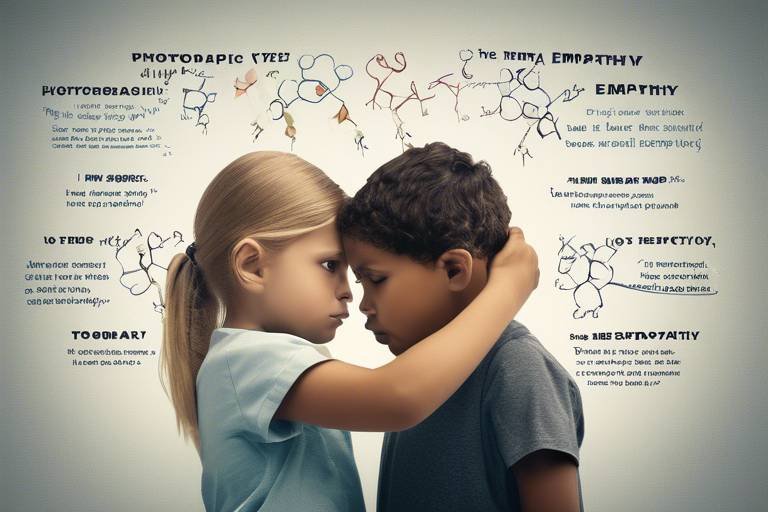The Science of Empathy - Understanding Others
Empathy is a fascinating and complex emotion that plays a pivotal role in our interactions with others. It’s more than just feeling sorry for someone; it’s about truly understanding their feelings and experiences. In a world that often feels disconnected, empathy acts as a bridge, allowing us to connect on a deeper level. But what exactly is empathy? How does it work? And why is it so essential in our daily lives? This article will take you on a journey through the intricate landscape of empathy, exploring its psychological foundations, neurological mechanisms, and its profound impact on our relationships and society.
Empathy is often misunderstood, with many people equating it to sympathy. While sympathy involves feeling pity for someone else's misfortunes, empathy goes a step further. It’s about stepping into another person’s shoes and experiencing their emotions as if they were your own. There are two primary types of empathy: cognitive empathy and emotional empathy. Cognitive empathy refers to the ability to understand someone else's perspective, while emotional empathy is the capacity to physically feel what another person is feeling. Both forms are essential for fostering genuine connections and improving our interactions.
Did you know that empathy is deeply rooted in our brain's structure? Neuroscientific research has revealed that certain brain regions are activated when we empathize with others. For instance, mirror neurons play a crucial role in our ability to understand and share the emotions of others. When we see someone experiencing joy or pain, these neurons fire, creating a sense of shared experience. This neural mechanism is fundamental to our capacity for empathy, enabling us to connect with others on an emotional level.
Emotional intelligence is a term that has gained significant traction in recent years, and empathy is one of its core components. A person with high emotional intelligence is not only aware of their own emotions but also adept at recognizing and responding to the emotions of others. This heightened awareness enhances communication and fosters stronger relationships, both personally and professionally. Imagine a workplace where colleagues genuinely understand and support each other—this is the power of empathy in action.
The seeds of empathy are sown during childhood. From an early age, children learn to recognize and respond to the emotions of those around them through social interactions and parental guidance. Nurturing empathetic behaviors during these formative years is crucial. Parents and caregivers can foster empathy by modeling compassionate behavior and encouraging children to express their feelings. Engaging in activities such as role-playing or discussing emotions can also help children develop a robust sense of empathy.
In adult relationships, empathy becomes even more vital. It serves as a foundation for conflict resolution and emotional support. When partners or friends communicate empathetically, they create a safe space for vulnerability, allowing for deeper connections. Imagine a couple navigating a disagreement; if they approach the situation with empathy, they are more likely to understand each other's perspectives and find common ground. This empathetic communication strengthens bonds and promotes healthier, more fulfilling relationships.
Empathy significantly impacts mental health, both positively and negatively. On one hand, empathetic connections can alleviate feelings of loneliness and isolation. Sharing in the joys and sorrows of others can create a sense of belonging and support. However, it's essential to recognize that empathy can also lead to emotional burnout, particularly for caregivers who consistently put others' needs before their own. Striking a balance between being empathetic and maintaining one’s emotional well-being is crucial.
Empathy is not just an individual trait; it can be cultivated on a societal level. Communities, workplaces, and educational institutions can implement strategies to promote empathy. For instance, incorporating empathy training programs in schools can help children develop this vital skill early on. In workplaces, encouraging open dialogues about emotions can foster a culture of understanding. The benefits of a more empathetic society are profound, leading to improved relationships and a greater sense of community.
It's fascinating to note that empathy is experienced and expressed differently across cultures. What might be considered an empathetic gesture in one culture could be perceived differently in another. Understanding these cultural variations is essential, especially in our increasingly globalized world. By appreciating diverse expressions of empathy, we can foster more meaningful connections with people from various backgrounds.
The study of empathy is evolving rapidly. Emerging research areas are exploring the neurological basis of empathy, potential technological advancements, and how our understanding of empathy can shape future psychological practices and societal norms. As we continue to delve deeper into the science of empathy, we may uncover new ways to enhance our connections and improve overall emotional well-being.
- What is the difference between empathy and sympathy? Empathy involves understanding and sharing another person's emotions, while sympathy is feeling pity for someone else's misfortunes.
- Can empathy be learned? Yes, empathy can be cultivated through social interactions, education, and by modeling compassionate behavior.
- How does empathy affect mental health? Empathetic connections can alleviate loneliness but may also lead to emotional burnout, especially for caregivers.
- Is empathy universal? While the capacity for empathy exists across cultures, its expression can vary significantly, highlighting the need for cultural sensitivity.

The Definition of Empathy
Empathy is often misunderstood, with many people confusing it with sympathy. While sympathy involves feeling pity for someone else's misfortune, empathy goes much deeper. It is the ability to understand and share the feelings of another. Imagine walking a mile in someone else's shoes; that’s empathy in action. It’s about connecting with others on an emotional level, truly grasping their experiences, and resonating with their emotions.
To break it down further, we can distinguish between two primary types of empathy: cognitive empathy and emotional empathy. Cognitive empathy refers to the capacity to comprehend another person's perspective or mental state. It’s like having a map of someone’s thoughts and feelings, allowing you to navigate their emotional landscape without necessarily feeling what they feel. On the other hand, emotional empathy involves actually feeling what another person is experiencing. This is where the emotional connection becomes palpable, as you can almost feel their joy or pain as if it were your own.
Understanding these two forms of empathy is crucial because they play distinct roles in our interactions. For instance, in a heated argument, cognitive empathy can help you see where the other person is coming from, while emotional empathy allows you to connect with their feelings, potentially diffusing tension. Both forms are essential for fostering strong relationships and promoting effective communication.
Empathy is not just a personal trait; it is a vital social skill that can be developed and enhanced over time. In fact, studies have shown that individuals who actively practice empathy tend to have better relationships, improved communication skills, and a greater overall sense of well-being. So, whether you're navigating personal relationships or professional environments, honing your empathetic abilities can lead to more meaningful connections.
In summary, empathy is a multifaceted concept that encompasses both cognitive and emotional dimensions. By understanding these different aspects, we can better appreciate the importance of empathy in our lives and the lives of those around us. It is this profound ability to connect with others that enriches our human experience and fosters a more compassionate world.
- What is the difference between empathy and sympathy? Empathy involves understanding and sharing feelings, while sympathy is feeling pity for someone else's situation.
- Can empathy be learned? Yes, empathy can be developed through practice and conscious effort in understanding others' perspectives.
- Why is empathy important in relationships? Empathy fosters connection, improves communication, and helps resolve conflicts, leading to healthier relationships.

The Neuroscience Behind Empathy
Empathy is not just a warm, fuzzy feeling we get when we connect with someone; it's a complex neuroscientific phenomenon that involves intricate processes in our brains. Imagine your brain as a well-oiled machine, where different parts work together to help you understand and resonate with the emotions of others. At the heart of this process are mirror neurons, which play a pivotal role in our ability to empathize. These neurons fire both when we perform an action and when we observe someone else performing that same action. It's as if our brains are saying, "I see you, and I feel what you're feeling."
Research has shown that when we witness someone experiencing joy, pain, or even frustration, our brain activates similar regions that would light up if we were experiencing those emotions ourselves. This mechanism allows us to connect deeply with others, creating a sense of shared experience. But it's not just mirror neurons at play; several other brain regions contribute to our empathetic responses. For instance, the anterior insula and the anterior cingulate cortex are crucial for processing emotions and understanding the feelings of others.
To illustrate this further, consider the following table that summarizes key brain regions involved in empathy:
| Brain Region | Function |
|---|---|
| Mirror Neurons | Facilitate understanding of others' actions and emotions |
| Anterio Insula | Processes emotional awareness and subjective feelings |
| Anterio Cingulate Cortex | Involved in emotional regulation and empathy |
| Prefrontal Cortex | Helps in decision-making and social interactions |
This intricate interplay of brain functions is what allows us to not only recognize the emotions of others but also respond appropriately. Think of it like a dance: when one partner leads, the other follows, and both are in sync. This synchronization is crucial for developing strong interpersonal relationships, as it fosters understanding and compassion.
Moreover, studies have shown that certain factors can influence our capacity for empathy. For instance, environmental factors such as upbringing, social experiences, and cultural background can either enhance or inhibit our empathetic responses. In a nurturing environment where emotional expression is encouraged, individuals tend to develop stronger empathetic abilities. Conversely, a lack of emotional support can lead to difficulties in understanding and relating to others' feelings.
In summary, the neuroscience behind empathy is a fascinating blend of biology and psychology. Our brains are wired to connect, understand, and resonate with one another's experiences. By delving into the neural mechanisms that underpin empathy, we can better appreciate the profound impact it has on our relationships and emotional well-being. As we continue to explore this intricate web of connections, we open the door to enhancing our emotional intelligence and fostering deeper connections with those around us.
- What are mirror neurons? Mirror neurons are brain cells that respond both when we perform an action and when we observe someone else performing that action, helping us understand others' feelings.
- How does empathy affect relationships? Empathy enhances communication and emotional support, leading to stronger and healthier relationships.
- Can empathy be learned? Yes, empathy can be cultivated through social interactions, education, and positive role models.

When we think about emotional intelligence, it's easy to get lost in the technical jargon and psychological theories. But at its core, emotional intelligence (EI) is about understanding our own emotions and the emotions of others. Imagine walking into a room and instantly sensing the mood—whether it's joyful, tense, or melancholic. That instinctive understanding is a glimpse into the world of empathy, a vital component of emotional intelligence. So, what exactly is the connection between these two concepts? Let's dive deeper.
Empathy is the ability to not just recognize emotions in others but to actually feel and resonate with those emotions. It’s like putting yourself in someone else's shoes and experiencing their journey firsthand. This capability is crucial for emotional intelligence because it allows us to navigate social situations with grace and understanding. When we can empathize, we can respond appropriately to others' feelings, leading to improved communication and stronger relationships.
To break it down further, emotional intelligence can be divided into several key components, with empathy being a cornerstone. These components include:
- Self-awareness: Recognizing your own emotions and how they affect your thoughts and behavior.
- Self-regulation: The ability to control or redirect disruptive emotions and impulses.
- Motivation: Harnessing emotions to pursue goals with energy and persistence.
- Empathy: Understanding the emotional makeup of other people and treating them according to their emotional reactions.
- Social skills: Managing relationships to move people in desired directions.
Each of these components interplays with empathy, enhancing our ability to connect with others. For instance, a leader who possesses high emotional intelligence can read the room during a meeting, sensing when a team member is struggling or feeling overwhelmed. Instead of pushing forward with a rigid agenda, they might choose to pause and address the emotional climate, fostering a supportive environment. This not only boosts morale but also strengthens the trust within the team.
Furthermore, empathy enhances our communication skills. When we truly listen to someone, not just with our ears but with our hearts, we create a space for open dialogue. This is particularly important in personal and professional relationships where misunderstandings can lead to conflict. By practicing empathy, we can avoid many pitfalls that arise from miscommunication.
In the workplace, organizations that prioritize emotional intelligence and empathy see remarkable benefits. These include:
- Increased employee satisfaction and retention.
- Improved teamwork and collaboration.
- Enhanced problem-solving capabilities.
- Greater adaptability to change.
In conclusion, empathy is not just a trait; it's a skill that can be cultivated and nurtured. By developing our emotional intelligence, we can enhance our empathetic abilities, leading to richer relationships and a more harmonious environment, whether at home or at work. So, the next time you find yourself in a conversation, take a moment to tune into the other person's feelings. You might be surprised at how much deeper your connection can become.
- What is the difference between empathy and sympathy? Empathy involves understanding and sharing the feelings of another, while sympathy is feeling pity or sorrow for someone else's misfortune.
- Can empathy be learned? Yes! Empathy can be developed through practice, self-reflection, and active listening.
- How does empathy impact leadership? Empathetic leaders can foster trust, improve team dynamics, and create a supportive work environment, leading to higher productivity.

Empathy is a vital skill that begins to develop in early childhood, laying the foundation for how we connect with others throughout our lives. But how does this intricate process unfold? Children are like sponges, absorbing emotions and social cues from their surroundings. From their very first interactions, they start to pick up on the feelings of those around them, which is crucial for their emotional growth. Parents, caregivers, and peers play significant roles in nurturing this ability, providing a rich tapestry of experiences that help shape empathetic behavior.
At a young age, children often exhibit signs of empathy, such as showing concern when a friend is upset or sharing toys with others. These actions, while seemingly simple, are the building blocks of a more complex emotional framework. For instance, when a child sees another child crying, their instinct might be to comfort them, demonstrating an early understanding of shared feelings. This is often referred to as emotional contagion, where emotions are mirrored and felt by others. But how can we ensure that these behaviors are encouraged and developed further?
Here are some effective ways to cultivate empathy in children:
- Model Empathetic Behavior: Children learn by example. When adults demonstrate empathy—by actively listening, validating feelings, and showing kindness—children are likely to mimic these behaviors.
- Encourage Perspective-Taking: Engage children in discussions about how others might feel in various situations. Asking questions like, "How do you think your friend felt when that happened?" helps them consider different viewpoints.
- Provide Opportunities for Social Interaction: Playdates, group activities, and collaborative projects can help children practice empathy in real-life scenarios, allowing them to navigate social dynamics and understand the feelings of others.
- Read Books Together: Sharing stories that explore emotions can be a powerful tool. Discussing characters' feelings and motivations fosters an understanding of complex emotional landscapes.
Furthermore, the role of parental guidance cannot be overstated. When caregivers actively engage in conversations about emotions and model empathetic responses, they create a safe environment for children to express their feelings. This nurturing approach not only enhances a child's emotional intelligence but also strengthens the parent-child bond. As children grow, the lessons learned during these formative years will serve as a compass for navigating the complexities of human relationships.
Ultimately, cultivating empathy in childhood is not just about teaching a skill; it's about fostering a sense of belonging and connection to others. As children learn to understand and share the feelings of those around them, they develop a more profound sense of compassion, which will guide them throughout their lives. By prioritizing empathy in early development, we can pave the way for a more understanding and connected society.
Q: At what age do children start to show signs of empathy?
A: Children can start to show signs of empathy as early as 2 years old, often through actions like comforting a crying friend or sharing toys.
Q: How can I help my child develop empathy?
A: You can help develop empathy by modeling empathetic behavior, encouraging perspective-taking, providing social interaction opportunities, and discussing emotions through stories.
Q: Is empathy something that can be taught?
A: Yes, empathy can be cultivated through intentional practices, such as engaging in discussions about feelings and encouraging children to understand different perspectives.

When it comes to adult relationships, whether they are romantic, platonic, or professional, empathy is like the glue that holds everything together. Imagine trying to build a house without any nails or screws; that’s what relationships can feel like without empathy. It’s not just about understanding someone’s feelings; it’s about connecting with them on a deeper level, recognizing their struggles, and being there for them. This emotional connection fosters trust and intimacy, which are essential for any healthy relationship.
Empathy allows us to step into another person's shoes, seeing the world through their eyes. This ability is crucial during conflicts, where miscommunication often leads to misunderstandings. For instance, when a partner feels neglected, instead of brushing off their feelings, an empathetic response might involve acknowledging their feelings and discussing the issue openly. This kind of communication not only resolves the conflict but also strengthens the bond between individuals.
Moreover, empathy enhances our ability to provide emotional support. In a world where everyone is often caught up in their own struggles, being able to listen and respond with compassion can make a significant difference. When we show empathy, we validate the other person's feelings, which can be incredibly comforting. For example, if a friend is going through a tough time at work, simply saying, “I understand how you feel; that sounds really challenging,” can create a safe space for them to express their emotions without fear of judgment.
However, it’s important to note that empathy is not just about being a good listener. It involves active engagement, where you not only hear what someone is saying but also respond in a way that shows you truly care. This can involve asking open-ended questions, reflecting back what you’ve heard, and offering support in a way that feels genuine to the other person.
Let’s not forget that empathy also plays a significant role in our professional relationships. In workplaces where empathy is encouraged, employees feel more valued and understood. This can lead to increased collaboration and productivity. For example, leaders who practice empathetic management often see lower turnover rates and higher employee satisfaction. By fostering an empathetic environment, organizations can cultivate a culture of trust and respect.
In summary, empathy in adult relationships is about more than just understanding; it’s about connection, support, and communication. It transforms how we interact with each other, making our relationships not only more fulfilling but also more resilient. So, the next time you find yourself in a conversation, ask yourself: Am I truly listening? Am I connecting? These questions can guide you toward fostering deeper, more meaningful relationships.
- What is empathy? Empathy is the ability to understand and share the feelings of another person, allowing for deeper connections and emotional support.
- How can I improve my empathy skills? You can improve empathy by actively listening, engaging in conversations, and trying to understand others' perspectives.
- Why is empathy important in relationships? Empathy is crucial in relationships as it fosters trust, emotional support, and effective communication, leading to healthier interactions.
- Can empathy be learned? Yes, empathy can be cultivated through practice, self-reflection, and by being open to the experiences of others.

Empathy is a powerful force that shapes our emotional landscapes, influencing not only how we connect with others but also how we perceive and manage our own mental health. At its core, empathy allows us to step into someone else's shoes, to feel their joy, sorrow, and everything in between. This connection can lead to profound benefits for our mental well-being, as it fosters feelings of belonging and reduces isolation.
When we engage in empathetic interactions, we create a supportive environment that can significantly alleviate feelings of loneliness and despair. For instance, studies have shown that individuals who experience high levels of empathy tend to have stronger social networks, which in turn can act as a buffer against mental health issues such as depression and anxiety. The emotional support derived from these connections can be likened to a safety net, catching us when we fall and providing comfort during turbulent times.
However, while empathy can be a source of strength, it can also lead to emotional burnout, especially for caregivers and those in helping professions. The weight of consistently feeling others' pain can be overwhelming. This phenomenon is often referred to as "compassion fatigue," where the emotional toll of empathy becomes too much to bear. It's essential to recognize the signs of this burnout, which may include:
- Emotional exhaustion
- Reduced sense of personal accomplishment
- Increased cynicism towards others
To maintain a healthy balance, it's crucial for individuals in empathetic roles to practice self-care and set boundaries. Engaging in activities that replenish emotional reserves, such as mindfulness practices or hobbies, can help mitigate the negative effects of empathy. Just like a battery needs recharging, our emotional health requires regular maintenance to avoid depletion.
Moreover, empathy can also play a role in therapeutic settings. Therapists and counselors who exhibit high levels of empathy not only create a safe space for clients but also facilitate deeper understanding and healing. The therapeutic alliance—a bond formed between therapist and client—thrives on the foundation of empathy, allowing for more effective communication and emotional processing. This connection can lead to transformative experiences, where clients feel truly heard and validated.
In conclusion, empathy is a double-edged sword in the realm of mental health. It can foster connections that enhance our emotional well-being and provide critical support during challenging times. Yet, it also requires careful management to prevent burnout and emotional exhaustion. By cultivating a balanced approach to empathy, we can harness its power to improve not only our mental health but also the well-being of those around us.
- What is the difference between empathy and sympathy? Empathy involves understanding and sharing the feelings of another, while sympathy is feeling pity or sorrow for someone else's misfortune.
- Can empathy be learned? Yes, empathy can be cultivated through practice, education, and positive social interactions.
- How does empathy affect relationships? Empathy strengthens relationships by enhancing communication, trust, and emotional intimacy.
- What are the signs of empathy burnout? Signs include emotional exhaustion, a decrease in personal accomplishment, and increased cynicism.

In a world that often feels divided, cultivating empathy within society is more important than ever. Empathy is not just a personal quality; it’s a social necessity. Imagine a world where people actively seek to understand each other’s perspectives, where compassion reigns over conflict. It sounds utopian, right? But the good news is that empathy can be nurtured and developed through intentional practices and community efforts.
One of the most effective ways to cultivate empathy is through education. Schools play a pivotal role in shaping young minds, and incorporating empathy training into the curriculum can have profound effects. When children learn about empathy through storytelling, role-playing, and discussions about emotions, they develop the ability to relate to others' feelings. This foundational skill not only enhances their emotional intelligence but also prepares them for healthier relationships as they grow. For instance, teaching children to recognize and articulate their emotions can create a ripple effect, encouraging them to be more understanding of their peers.
Moreover, community programs that promote social interaction can significantly enhance empathetic behaviors. Initiatives like community service, mentorship programs, and cultural exchange activities allow individuals from different backgrounds to share their stories and experiences. When people engage with others outside their usual circles, they often discover commonalities that bridge gaps and foster understanding. For example, a community service project where participants work together to solve local issues can create bonds and encourage a sense of shared humanity.
Workplaces also have a critical role in fostering empathy. Companies that prioritize a culture of empathy often see improved employee morale and collaboration. Training sessions focused on active listening, emotional awareness, and conflict resolution can transform the workplace environment. When employees feel heard and understood, they are more likely to contribute positively to the team dynamic. In fact, studies have shown that organizations with high levels of empathy report lower turnover rates and increased productivity.
In addition to structured programs, media and storytelling can be powerful tools for cultivating empathy in society. Films, books, and even social media can introduce us to diverse perspectives and experiences. When we consume stories that challenge our viewpoints, we are invited to step into someone else’s shoes. This exposure can be transformative, encouraging us to reflect on our biases and assumptions. The more we engage with stories that highlight different cultures and life experiences, the more we cultivate a society that values empathy.
Finally, it’s essential to recognize that cultivating empathy is an ongoing journey. It requires consistent effort and a willingness to engage with discomfort. As we strive to understand others, we may encounter differing opinions and experiences that challenge our beliefs. However, embracing these challenges is part of the process. By fostering open conversations and encouraging vulnerability, we can create a society where empathy thrives.
In conclusion, cultivating empathy within society is not just a lofty ideal; it is a practical necessity. Through education, community engagement, workplace culture, and storytelling, we can create an environment that nurtures understanding and compassion. The journey towards a more empathetic society begins with each of us. Are you ready to take the first step?
- What is empathy? Empathy is the ability to understand and share the feelings of others, allowing us to connect on a deeper emotional level.
- How can empathy be taught? Empathy can be taught through educational programs that include role-playing, discussions about emotions, and exposure to diverse perspectives.
- Why is empathy important in the workplace? Empathy enhances communication, fosters collaboration, and creates a positive work environment, leading to higher productivity and lower turnover rates.
- Can empathy be cultivated in adults? Yes, adults can cultivate empathy through ongoing self-reflection, engaging with diverse communities, and practicing active listening.

Empathy is a universal human experience, yet its expression can vary significantly across different cultures. Just like a beautiful tapestry woven from diverse threads, the way we empathize is influenced by our cultural backgrounds, beliefs, and social norms. Understanding these differences is crucial, especially in our increasingly globalized world where interactions with people from various cultures are commonplace.
In many Western cultures, empathy is often expressed openly and is closely tied to individualism. Here, people are encouraged to share their feelings and thoughts, which fosters a strong sense of emotional connection. For instance, in the United States, a common response to someone in distress might be to offer verbal support or physical comfort, like a hug. This direct approach to empathy highlights the value placed on personal expression and emotional transparency.
Conversely, in many Eastern cultures, such as those in Japan or China, empathy may be expressed more subtly. The emphasis here is often on maintaining harmony and avoiding conflict. Instead of openly discussing feelings, individuals might demonstrate empathy through actions rather than words. For example, a friend may cook a meal for someone going through a tough time, rather than directly addressing their emotional state. This indirect approach reflects the cultural priority placed on group cohesion and social harmony.
Moreover, cultural norms can dictate the appropriateness of empathetic expressions. In some cultures, showing too much emotion can be seen as a sign of weakness, while in others, it is celebrated as a strength. For instance, in Mediterranean cultures, emotional expressiveness is often embraced, and empathy is shown through passionate discussions and physical gestures. In contrast, Scandinavian cultures may value stoicism, where empathy is conveyed more through actions than through verbal expressions.
It's fascinating to consider how empathy can be perceived differently. In a multicultural setting, misunderstandings can arise if individuals are unaware of these cultural nuances. For example, a person from a culture that values direct communication might misinterpret a more reserved individual's behavior as indifference, while the reserved person is genuinely concerned but expressing it in a culturally appropriate manner.
To bridge these cultural gaps, it is essential to cultivate an awareness of different empathetic expressions. Here are some strategies that can help:
- Active Listening: Pay attention not just to words but also to non-verbal cues, which can vary significantly across cultures.
- Ask Questions: If unsure how to interpret someone's response, ask open-ended questions to clarify their feelings.
- Educate Yourself: Learn about different cultural practices and values regarding emotions and empathy.
By embracing these strategies, we can enhance our ability to empathize across cultures, fostering deeper connections and understanding. Empathy is not just about feeling for someone; it's about recognizing and respecting the unique ways people express their emotions and experiences. In this way, we can create a more inclusive and compassionate world.
Q: How does culture influence empathy?
A: Culture shapes the way empathy is expressed and perceived. Different cultures have varying norms regarding emotional expression, which can affect how individuals communicate their feelings and respond to others.
Q: Can empathy be learned?
A: Yes, empathy can be cultivated through education, practice, and exposure to diverse perspectives. Engaging with different cultures and experiences can enhance empathetic skills.
Q: What are some ways to improve empathy in multicultural settings?
A: Active listening, asking clarifying questions, and educating oneself about different cultural practices can help improve empathy in diverse environments.

The study of empathy is rapidly evolving, driven by advancements in technology and a deeper understanding of human psychology. As researchers delve into the complexities of empathetic behavior, they uncover new insights that could revolutionize how we approach interpersonal relationships and mental health. One of the most exciting areas of future research lies in the intersection of empathy and technology. With the rise of artificial intelligence and virtual reality, scientists are beginning to explore how these tools can enhance our understanding of empathy and even foster it in real-world settings.
Imagine a world where virtual reality experiences allow individuals to step into the shoes of others, experiencing their emotions and challenges firsthand. This immersive approach could bridge the empathy gap, particularly in communities that struggle with understanding diverse perspectives. Research is already underway to assess how these technologies can create a more empathetic society. For instance, studies have shown that participants who engage in VR simulations that depict the struggles of marginalized groups report increased empathy towards those individuals. This suggests a promising avenue for future exploration.
Moreover, neuroscience continues to play a pivotal role in empathy research. As we learn more about the brain's wiring and the neural mechanisms that underpin empathetic responses, we can develop targeted interventions to enhance empathy in various populations. For example, understanding how mirror neurons function could lead to new therapies for individuals with social cognitive deficits, such as those on the autism spectrum. By harnessing this knowledge, we can create programs that specifically aim to cultivate empathy, thereby improving social interactions and emotional well-being.
Additionally, the role of empathy in mental health is gaining traction. Future studies are likely to focus on how empathetic connections can serve as a buffer against mental health issues. For instance, research might explore how empathy-driven support networks can alleviate symptoms of anxiety and depression. This could lead to innovative therapeutic approaches that prioritize building empathetic relationships as a foundational element of mental health care.
As we look to the future, it’s essential to consider the ethical implications of empathy research. With the potential for technology to manipulate emotional responses, researchers must tread carefully. Questions arise about consent, authenticity, and the impact of artificially induced empathy. Balancing the benefits of these advancements with ethical considerations will be crucial in shaping the future landscape of empathy research.
In conclusion, the future of empathy research is bright and filled with possibilities. By leveraging technology, deepening our understanding of neuroscience, and prioritizing mental health, we can foster a more empathetic society. As we continue to explore these avenues, one thing is clear: empathy is not just a human trait; it’s a powerful tool that can transform our interactions and improve our world.
- What is empathy? Empathy is the ability to understand and share the feelings of another person, encompassing both cognitive and emotional dimensions.
- How can technology enhance empathy? Technologies like virtual reality can simulate experiences that help individuals understand others' perspectives, potentially increasing empathetic responses.
- Why is empathy important in mental health? Empathetic connections can reduce feelings of isolation and provide crucial support, which can alleviate symptoms of mental health issues.
- What ethical considerations are there in empathy research? Researchers must consider the implications of manipulating emotional responses and ensure that empathy-enhancing technologies are used responsibly.
Frequently Asked Questions
- What is empathy?
Empathy is the ability to understand and share the feelings of others. It involves both cognitive aspects, like recognizing someone else's emotions, and emotional aspects, which include feeling those emotions yourself. It's not just about being sympathetic; it's about genuinely connecting with others on an emotional level.
- Why is empathy important in relationships?
Empathy is crucial in relationships because it fosters deeper connections and understanding. When we empathize with others, we can communicate better, resolve conflicts more effectively, and provide emotional support. Think of it as the glue that holds relationships together, allowing people to feel seen and heard.
- How does empathy develop in children?
Children learn empathy through social interactions and guidance from parents and caregivers. As they observe emotional responses in others and experience their own feelings, they begin to understand the importance of empathy. Encouraging empathetic behaviors during formative years can significantly shape a child's emotional intelligence.
- Can empathy have negative effects?
Yes, while empathy is generally positive, it can lead to emotional burnout, especially in caregivers or those in helping professions. When individuals feel overwhelmed by others' emotions without proper self-care, it can negatively impact their mental health. Balancing empathy with self-awareness is key to maintaining emotional well-being.
- How can we cultivate empathy in society?
Empathy can be fostered through community initiatives, educational programs, and workplace training that emphasize understanding and compassion. Activities like storytelling, role-playing, and community service can help individuals practice empathy, leading to a more connected and supportive society.
- Are there cultural differences in how empathy is expressed?
Absolutely! Empathy can vary significantly across cultures. Some cultures may prioritize collective well-being and emotional expression, while others might emphasize individualism and restraint. Understanding these differences is vital in our globalized world, as it helps us navigate interactions with sensitivity and respect.
- What does the future of empathy research look like?
The future of empathy research is promising, with emerging studies focusing on the neurological basis of empathy, its role in technology, and its application in therapeutic settings. As we continue to explore empathy, we may uncover new ways to enhance emotional connections and improve mental health practices.



















